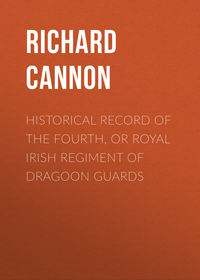 полная версия
полная версияHistorical Record of the First Regiment of Foot
While the brigade lay at Wurtzburg, the King sent out so many detachments that he had only about ten thousand men at head-quarters, and an army of fifty thousand men, commanded by the Duke of Lorraine, advanced against him. His Majesty having received information that the enemy designed to pass the Maine at Oxenford and attack him, the King proceeded, on the same evening, after dark, to the quarters of Hepburns's Scots Brigade, and commanded the men to assemble under arms immediately. Having selected eight hundred musketeers, his Majesty commanded them to follow him, while the pikemen and colours remained behind. The musketeers, being led by Brigadier-General Hepburn, and accompanied by eighty Swedish horsemen, continued their march throughout the night, and at two o'clock on the following morning arrived at Oxenford, and formed up in the market-place, while fifty of the horsemen advanced to observe the motions of the enemy. Soon afterwards the report of pistols was heard, when his Majesty sent out a lieutenant and fifty musketeers to skirmish and to cover the retreat of the horse, which service was gallantly performed. The enemy, however, proved too numerous, and the fifty musketeers were forced to retire, when the King sent a hundred musketeers, under Lieutenant-Colonel Monro, to restore the fight, and they drove back a superior body of the Imperialists, for which they were applauded by the King. These few Scots having thus frustrated the designs of the enemy, his Majesty returned to Wurtzburg, leaving Hepburn, with his musketeers, to defend the place; and this excellent officer made such a formidable disposition of his men, and kept so good a countenance, that, although the enemy advanced with his army up to the town with drums beating and colours flying, as though he was about to storm the place, yet he afterwards retired. The musketeers, having thus boldly confronted a large army and maintained their post, were afterwards ordered to return to Wurtzburg.
On the 7th of November Hepburn's Scots Brigade, or the Green Brigade, advanced with the army towards Frankfort on the Maine, a place celebrated throughout Europe for its annual fairs; and while traversing the rich plains and beautiful scenery of one of the most fruitful parts of Germany, several strong towns surrendered to the army. The brigade crossed the Maine at Aschaffenberg, on the 14th of November, and arrived at Frankfort on the 16th, when the city surrendered.
In the early part of December Hepburn's or the Green, and the Blue brigades, were employed in the siege of a strong fort near Oppenheim, and while performing this service, these hardy veterans were encamped in the midst of a deep snow. The enemy made a sally in the night, but were repulsed by the Scots pikemen, and on the following morning the fort surrendered. The two brigades afterwards attacked a fort, and also the castle belonging to the town. A party of gallant Scots having stormed the wall between the outward fort and castle, they found the drawbridge down, and, forcing an entrance into the castle, they put the Spanish garrison to the sword; at the same time another party stormed the fort with such fury that nine companies of Italians were soon overpowered and forced to surrender. These Italians afterwards engaged in the Swedish service, and were attached to the Green Brigade; but they all deserted during the following summer. The King having passed the Rhine with part of his army to attack the town on the other side, the place surrendered.
Notwithstanding the severity of the season, the King resolved to continue operations, and one Sunday afternoon, in the early part of December, in tempestuous weather, with frost and snow, the army appeared before Mentz. Hepburn's Scots,27 or the Green Brigade, took its post before the town; and the men having prepared the batteries during the night, the fire of the cannon commenced at day-break with such fury that the besieged were dismayed, and they surrendered in the middle of December. The brigade was afterwards placed in garrison in the town, where it continued during the remainder of the winter.
1632During the preceding campaign, several additional regiments arrived in Germany from Scotland, namely, Sir James Lumsdell's, the Master of Forbes', Sir Frederick Hamilton's, and Colonel Monro's; also Colonel Austin's English regiment; recruits also arrived for the old regiments; and in the beginning of 1632 there appear to have been thirteen Scots regiments and five English regiments in the service of the King of Sweden. There were also two Scots generals, three major-generals, three brigadier-generals, twenty-seven colonels, fifty-one lieutenant-colonels, and fourteen Scots majors,28 in the Swedish army: and the First, or Royal, Regiment of Foot, in the British line, being the only one of these eighteen British regiments which has continued to exist to the present time, it is the representative of the whole of this gallant force.
Hepburn's veterans remained in garrison at Mentz, recruiting in vigour and in numbers, until the beginning of March, 1632, when they proceeded to Frankfort on the Maine, and, advancing from thence to Aschaffenberg, were reviewed in the fields before the town on the 6th of March, by the King of Sweden. From Aschaffenberg the brigade continued its march to Weinsheim, where it was reviewed by the Elector Palatine, who complimented this distinguished body of Scots on the high character it had acquired for deeds of valour.
After this review the brigade advanced with the army to invade Bavaria, and on the 26th of March it appeared before Donawerth on the Danube, when the King posted part of the troops on the heights above the town. On the following day, a battery having been constructed to command the bridge, the enemy made a furious sally, and, having driven back some Swedish troops, captured the guns; but a number of Hepburn's veterans rushing forward sword in hand, the Bavarians were repulsed and driven back into the town. During the night, Sir John Hepburn marched his brigade with great silence five miles up the Wernitz, and having crossed the river, returned by the opposite bank to an angle which commanded the bridge over the Danube, where he posted his musketeers behind garden-walls and hedges, and formed the pikemen into three bodies under the cover of the enclosures. At day-break the enemy's garrison attempted to force its way through the besieging army; eight hundred musketeers rushed suddenly out of the town towards the bridge where Hepburn's men were posted, when the Scots musketeers opened a destructive fire, and before the smoke had cleared away, the pikemen came cheering forward to the charge, while the musketeers drew their swords and joined in the attack, and the enemy's column was broken and cut to pieces. Many of the Bavarians fled towards the town; Hepburn's veterans, following in full career, entered the town with the fugitives, and made great slaughter in the streets. Meanwhile, the enemy's troops, which sallied on the other side of the town, were also nearly all destroyed. The governor escaped, but he saved only a small portion of his garrison. Thus Donawerth was captured in forty-eight hours after the army appeared before the town; and in this exploit the gallant veterans under Sir John Hepburn acquired new laurels.29
This success enabled the King to penetrate into Bavaria; and in the early part of April Hepburn's Brigade took part in the brilliant enterprise of forcing the passage of the river Lech in the face of a superior army, and the success which attended this daring exploit alarmed one half of Europe, and astonished the other.
The brigade was afterwards engaged in the siege of Augsburg, which place capitulated on the 10th of April. From Augsburg the brigade proceeded with the army to Ingoldstadt, and, being engaged in the siege of this town, it had one very trying night's service: the King, expecting a sally from the garrison, ordered Hepburn's veterans to stand all night under arms on some high ground near the town; the enemy kept up a constant fire against the brigade with dreadful execution, and the men had to stand like targets to be shot at, without the power of making resistance. "To my mind," observes the brave Colonel Monro, "it was the longest night in the year, though in April, for at one shot I lost twelve men of my own company." The first attack not succeeding, the King raised the siege and retired.
After quitting the precincts of Ingoldstadt, the brigade was detached against Landshut, a pretty little town with a castle, in Bavaria, which place surrendered on the 29th of April.
Having completed this conquest, the brigade proceeded to Freysingen, where it rejoined the main army, and advanced from thence to Munich. This celebrated city surrendered immediately, and the King being desirous of preserving it from plunder, he made a present of about five shillings English to every soldier in the army, and posted Hepburn's Scots Brigade at the bridge to prevent the ingress of stragglers. The army was afterwards encamped without the town, excepting the old Scots brigade, which entered the city with the King, and Hepburn's own regiment furnished the guard at the market-place, while the remainder of the brigade furnished the King's guard at the castle. As no other brigade was admitted into Munich, this circumstance proves the high estimation in which this old Scots corps was held. Its commander, Brigadier-General Hepburn, was appointed governor of Munich.
Leaving this city on the 1st of June, the brigade again directed its march towards Donawerth, where it arrived on the 4th. It subsequently marched to the relief of Weissemberg, which was besieged by the enemy; but the garrison surrendered before the troops marching for its relief arrived. The brigade then continued its march to Furt, where an encampment was formed. It was afterwards employed in several operations of a defensive character. The King having to defend Nurenberg, and to confront an army of 60,000 men with only 20,000, his Majesty formed an entrenched camp round the city, where the brigade was stationed some time.
The enemy's army, commanded by the Duke of Bavaria and Count Walstein, appeared before Nurenberg, and by means of their immense superiority of numbers endeavoured to cut off the supplies of provision from the Swedish army, but were unable to accomplish their object. The opposing armies lay watching each other's movements until the 21st of August, when, reinforcements having arrived for the Swedes, the King attacked the enemy's fortified camp; the old Scots Brigade was sharply engaged in the attack of the heights of Altenberg, and in the attempt on Altenberg Castle, in which service it lost many officers and men; but the attack failed at every point. The King afterwards formed a fortified camp within cannon shot of the enemy, and the two armies confronted each other until the 8th of September, when his Majesty retired, and five hundred musketeers of the old Scots Brigade, commanded by Lieutenant-Colonel Sinclair, covered the retreat to Neustadt. A few days afterwards, the Marquis of Hamilton being about to return to England, Brigadier-General Hepburn obtained permission to accompany him, and the regiment was left under the command of the Lieutenant-Colonel. When the gallant Hepburn and several other officers took leave of their companions in arms, Monro informs us that "the separation was like the separation which death makes betwixt friends and the soul of man, being sorry that those who had lived so long together in amity and friendship, also in mutual dangers, in weal and in woe, the splendour of our former mirth was overshadowed with a cloud of grief and sorrows, which dissolved in mutual tears."
The brigade was now commanded by Colonel Monro, and towards the end of September it marched to the relief of Rayn, which was besieged by the enemy; but this garrison also surrendered before the troops marching to its relief arrived. The King, however, resolved to retake the town, and having arrived before the walls on the 3rd of October, he took advantage of a thick fog, and brought his cannon to bear upon the works unperceived, when the garrison immediately surrendered.
The brigade being much exhausted and decreased in numbers from its recent hard services, it was placed in quarters of refreshment in Bavaria, while the King marched with part of the army into Saxony. Before his departure, his Majesty expressed his approbation of the conduct of these veteran Scots on all occasions, and exhorted the commanding officers to use every possible expedition in replacing the casualties in the ranks of their respective regiments; but this proved the final separation between the great Gustavus Adolphus and these distinguished regiments; his Majesty marched to Saxony, and was killed at the battle of Lützen,30 which was fought on the 6th of November, 1632.
After the death of the King of Sweden31 the old Scots Brigade served for a short time under the Elector Palatine, and was employed in the siege and capture of Landsberg, a town of Upper Bavaria on the Lech; and while before this place a dispute about precedence arose between this and another (Ruthven's) brigade: "But," observes Colonel Monro, "those of Ruthven's Brigade were forced, notwithstanding their diligence, to yield the precedence unto us, being older blades than themselves, for in effect we were their schoolmasters in discipline, as they could not but acknowledge."
When the capture of Landsberg was effected, the old Scots Brigade marched to the relief of Rayn, which was closely beset by the Bavarians, who raised the siege on the approach of the Scots, and retired into Saxony.
From Rayn the brigade marched to the vicinity of the ancient city of Augsburg, where the men lay two months of extreme cold weather in the open fields; the loss of the great Gustavus Adolphus was now seriously experienced, the generals were indecisive, and operations were suspended.
1633But in February, 1633, the brigade was again called into action. It proceeded, in the first instance, to Ulm, a considerable town on the banks of the Danube, and from thence towards Memmingen, to attack a division of the enemy stationed in the town; but, having halted at some hamlets within three miles of the place, the houses took fire in the night, and the brigade lost much baggage, and saved its cannon and ammunition with difficulty. This misfortune did not, however, prevent the troops from marching against their adversaries, who after some sharp skirmishing, retired.
Soon afterwards the brigade proceeded to Kaufbeuren, a small town on the Wertach, and having invested the place, the garrison held out two days, and then surrendered. Having refreshed the men with three days' rest at Kaufbeuren, the brigade marched with part of the army towards the Iller, and, having passed the river by a temporary bridge, besieged Kempten (the ancient Campodunum). But while the brigade lay before the town, it was suddenly ordered to proceed by forced marches to the Duchy of Wirtemberg.
Having been recalled from Wirtemberg, the brigade proceeded to Donawerth on the Danube, where it was stationed during a great part of the summer; while a convention of the Protestant princes of Germany was held at Heilbronn. The pay of the troops being a long time in arrear, they resolved not to engage in any further operations until their arrears were paid. Thus disorder and confusion found its way into the Swedish army, and the Scots regiments were no longer recruited with the same facility as formerly.
1634The old Scots Brigade, however, continued at its post of duty, and it formed part of the army, commanded by Marshal Horn and the Duke of Saxe-Weimar, which advanced to the relief of Nordlingen; and this movement brought on a general engagement, which was fought in the vicinity of the town on the 26th of August, 1634, when the confederates were defeated, and the Scots Brigade suffered so severely, that one of the regiments (Monro's) was reduced a few days afterwards to one company.32 After the battle, the wreck of this distinguished brigade retreated to Worms, a town situate on the left bank of the Rhine; and, Marshal Horn having been taken prisoner, the veteran Scots were under the orders of the Duke of Saxe-Weimar.
The loss of the battle of Nordlingen almost ruined the protestant interest in Germany, but soon afterwards the court of France agreed to support this depressed and declining cause. The prospect of immediate succours from France allayed the consternation which prevailed amongst the confederate princes. A French army approached the Rhine, and several towns in Alsace admitted French garrisons.
16351636During the summer of 1636 Hepburn's Regiment served with the army commanded by the Duke of Saxe-Weimar, and in the month of May it appeared before Saverne, a town of Alsace, situated on the banks of the river Sarre, which was defended by an Imperial garrison commanded by Colonel Mulhein. The siege of this place was immediately commenced, and the garrison made a desperate resistance. A breach having been effected, three assaults were made on the 20th of June, and were repulsed with great loss. On the following day the batteries against the town opened their fire with greater fury than before, and during the progress of the siege the gallant Sir John Hepburn33 was shot in the neck, and died, regretted, not only by his old companions in arms, but also by the court of France, where his valour and abilities were well known and appreciated. After holding out a few days longer the garrison surrendered; and Louis XIII. conferred the vacant Colonelcy of the regiment on Lieutenant-Colonel James Hepburn, whose name appears amongst the Scots lieutenant-colonels in the service of the King of Sweden in 1632.
1637The regiment appears to have continued to serve in Alsace, under the Duke of Saxe-Weimar, whose army consisted of French, Scots, Swedes, and Germans, in the pay of France; and during the year 1637 it was engaged in several skirmishes with the Imperialists, but no considerable action was performed by either side.
This year Colonel James Hepburn was killed, and he was succeeded in the command of the regiment by Lord James Douglas, second son of William, first Marquis of Douglas. From this period the regiment was known in France by the title of Le Régiment de Douglas.34
While the regiment was in Alsace, Picardy was invaded by the Spaniards, and in 1637 this corps of hardy Scots appears to have been withdrawn from the army commanded by the Duke of Saxe-Weimar, and stationed near the frontiers of Picardy.
1638In the spring of 1638 it was placed under the command of the Marshal de Chastillon, for the purpose of penetrating into the Earldom of Artois, which at this period formed part of the Spanish Netherlands.
After quitting the vicinity of St. Omer, the regiment was engaged in the siege of Renty, a small town on the river Aa. The army appeared before this place on the 1st of August, and on the 9th the garrison surrendered.
The next service in which the troops were employed was the siege of Catelet, a town of Picardy, which the Spaniards had captured in 1636; and this place was taken by storm on the 14th of September.
1639Having passed the winter in quarters in Picardy, Douglas' Regiment marched in the early part of May, 1639, to the rendezvous of the army at Doullens, and served this year against the Spaniards, forming part of the army commanded by General Meilleraie. The French commander marched first towards Aire, but after reconnoitering the defences of this place, he proceeded to Hesdin, – a town situated amongst marshes on the little river Canche, where he arrived on the 19th of May, and commenced the siege of the place with great vigour. Louis XIII. visited the camp, that his presence might animate the soldiers in their attacks; and, the garrison having surrendered on the 29th of June, the King was so well pleased with the manner in which this siege had been conducted, that he presented General Meilleraie with the baton of a Marshal of France; the ceremony was performed in the breach he had made in the fortress, and the King commanded Te Deum to be sung in the principal church of the town.35
After repairing the works, the army advanced against the Spanish forces under the Marquis de Fuentes; and Douglas' Regiment took part in a sharp skirmish near the village of St. Nicholas, on which occasion four pieces of cannon were captured from the Spaniards.
164016411642The regiment continued to take part in the military operations against the Spaniards. Meanwhile Scotland was violently agitated by an attempt made by King Charles I. to introduce the English Liturgy. This was followed by an unfortunate misunderstanding between the King and his Parliament in England, which produced a civil war; but, in the scenes of slaughter and devastation which followed, this regiment did not take part. It was in the service of Louis XIII. of France, who was engaged in a war with Austria and Spain; and the French King had urgent occasion for the presence of the three Scots regiments36 with his armies.
1643While the civil war was raging in England, Louis XIII. died (14th May, 1643), and was succeeded by his son Louis XIV., who was afterwards designated Louis le Grand; at the time of his accession he was in his minority. Notwithstanding this event the war was prosecuted with vigour, and the court of France procured, in 1643, an additional regiment of foot from Scotland, commanded by Colonel Andrew Rutherford,37 afterwards Earl of Teviot. This regiment was designated in France Le Régiment des Gardes Escossois, or the Regiment of Scots Guards: but the title was only honorary, as it was never employed near the royal person. The date of its formation has not been ascertained; but, as it was afterwards incorporated into Douglas' Regiment, now the First Royals, this corps is its representative, and its services have a place in this Memoir.
Immediately after the regiment of Scots Guards arrived in France, it was ordered to advance to the relief of Roucroy, a town of the Ardennes, which was besieged by the Spaniards. The troops employed in this service were commanded by Louis de Bourbon, Duc d'Enghien, who was afterwards celebrated for military achievements under the title of Prince of Condé, or the Great Condé. The Spaniards had a superiority of numbers: the two armies engaged near Roucroy, on the 19th of May, when the French gained a decisive victory, and captured the cannon, baggage, and many of the standards and colours belonging to the Spaniards. Rutherford's Scots' Regiment had the honor of taking part in this battle. It was soon afterwards employed in the siege of Thionville, a town situated on the river Moselle; and had one captain and four men killed, and one major and several private men wounded in the attack of the counterscarp. This siege being prosecuted with vigour, the town surrendered on the 10th of August, and the regiment appears to have marched immediately afterwards for Italy.
Meanwhile Douglas' Regiment had been removed from the Netherlands and placed under the orders of Prince Francis-Thomas of Savoy, who commanded the French army in Italy; and, having been engaged in several operations, it was employed in the autumn in the siege of the city of Turin, in Piedmont, which place was invested on the 14th of August. The Scots Regiment of Guards also arrived in Piedmont in time to take part in the siege, which was terminated on the 27th of September by the surrender of the city, when Douglas' Regiment was placed in garrison.38
1644Before the following campaign the regiment was, however, removed from Piedmont to Picardy; and passing from thence to the Netherlands, it served, in 1644, under the Duke of Orleans, who held, during the minority of Louis XIV., the title of Lieutenant-General to the King. The army in the Netherlands was this year of considerable magnitude, and Douglas' Regiment formed part of the division commanded by Marshal Meilleraie,39 and was engaged in the siege of Gravelines, a town situated on the river Aa, nine miles from Dunkirk. The communication of Gravelines with the sea rendered it a place of great importance to the Spaniards, who made strenuous exertions for its preservation. Two sorties were made by the garrison in the early part of July, when Douglas' Regiment was sharply engaged, and the enemy was repulsed. Every attempt made by the Spaniards to relieve the place was defeated, and the town surrendered on the 28th of July, 1644. This success was followed by the capture of several forts, and places of minor importance, near the sea.





